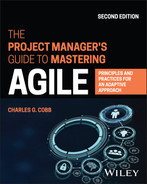PART 2
Agile Project Management Overview
AGILE IS CAUSING US TO broaden our vision of what a project manager is and that will have a dramatic impact on the potential roles that a project manager can play in an Agile project. In fact, the role of a project manager at a team level in a typical Agile/Scrum project is undefined. That will cause us to rethink many of the things we have taken for granted about project management for a long time to develop a broader vision of what an Agile Project Manager is. Some of the project management functions might be integrated into other roles and performed by someone who is not a dedicated project manager and who doesn’t have the title of “Project Manager.”
Chapter 5 – Agile Development, Quality, and Testing Practices:
You might ask: “Why does a Project Manager need to know something about development practices?” In the past, the role of a project manager might have been somewhat limited to a coordination function to integrate the efforts of the different functional organizations that played a role in the project.
In many cases, the actual functional direction for the different functions involved (development, test, etc.) came from the functional managers who were responsible for those functions themselves, and the role of the project manager in providing functional direction may have been limited.
An Agile environment is different—cross‐functional teams are much more integrated, and an Agile Project Manager needs to be a strong, cross‐functional leader.
Chapter 6 – Time‐Boxing, Kanban, and Theory of Constraints:
The typical way of modeling classical plan‐driven projects is based on a fairly statically defined model composed of work‐breakdown structures, Pert charts, Gantt charts, etc. An Agile approach is very different and is primarily oriented around managing the “flow” of requirements and tasks through an integrated development process. The tools that are most related to an understanding of managing “flow” are discussed in this chapter and include time‐boxing, Kanban, continuous flow, and theory of constraints.
An Agile estimation approach is very different from a classical plan‐driven project estimation approach:
- A classical plan‐driven project estimation approach is based on attempting to accurately pin down the requirements, costs, and schedule for the project upfront before the project starts and it is like a contractual commitment with the customer.
- An Agile estimation approach is based on much higher levels of uncertainty and that level of uncertainty needs to be openly and transparently shared with the customer based on a collaborative spirit of trust and partnership with the customer rather than an “arm's‐length” contractual relationship.
Chapter 8 – Agile Project Management Role:
Agile is causing us to broaden our vision of what project management is, and that will have a dramatic impact on the potential roles that a Project Manager can play in an Agile project.
The image of a Project Manager is typically very heavily focused around a plan‐driven development approach. That role will likely change dramatically in an Agile environment, and the formal role of a project manager, as we’ve known it, may even be eliminated, in some situations.
What is important; however, is not to preserve the role of a project manager, as we’ve known it, but learning to apply the discipline of project management in a much broader context and learning to blend classical plan‐driven principles and practices with more Agile and adaptive principles and practices in the right proportions to fit a given situation.
Chapter 9 – Agile Communications and Tools:
In my opinion, an Agile Project Manager who doesn’t know how to use one of the widely used Agile Project Management tools is equivalent to a traditional project manager who doesn’t know how to use Microsoft Project.
- Agile tools are fundamentally different from traditional project management tools like Microsoft Project.
- The fundamental difference is that traditional tools like Microsoft Project are heavily oriented around defining and managing the structure of project activities while Agile tools are more oriented around managing the flow of project activities through a much more fluid structure.
Chapter 10 – Learning to See the Big Picture:
An Agile Project Manager needs to understand the “big picture” behind Agile to fully realize how it works and why it makes sense. The key to that is to develop a systems thinking approach to understand Agile principles behind the Agile practices at a deeper level. Knowledge of Complex Adaptive Systems is also useful to understand the “big picture” behind Agile.
Chapter 11 – The Roots of Agile:
An Agile Project Manager needs to understand Agile at a deeper level in order to apply it to different situations effectively. In order to develop a systems thinking approach, it is valuable to understand the roots of Agile and know how Agile thinking evolved. There are two significant areas that had a huge impact on development of an Agile approach:
- Total Quality Management had a strong influence on the quality management approach in Agile
- Lean Manufacturing had a significant influence on the way an Agile process works from a process efficiency perspective.
